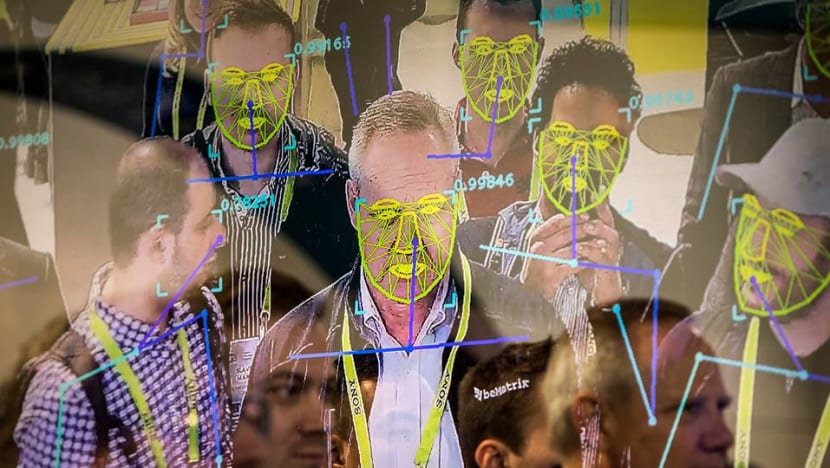Privacy, data security concerns as facial recognition becomes more common

In a double exposure image, facial-recognition software at the Consumer Electronics Show in Las Vegas, Jan 8, 2019. (File photo: The New York Times/Joe Buglewicz)
SINGAPORE: Used for everything from unlocking smartphones to boarding flights, the use of facial recognition technology is becoming increasingly ubiquitous.
But even as it becomes more commonplace, care must be taken to ensure it is not misused, say experts.
Facial recognition is increasingly being employed in Singapore. Earlier this month, it was announced that hotels here will be able to use an automated system which employs facial recognition to speed up the check-in process for visitors.
And by 2025, facial recognition – together with iris and fingerprint scans - will be implemented at all of Singapore’s immigration checkpoints, as part of border security efforts under the National AI Strategy announced by Deputy Prime Minister Heng Swee Keat on Nov 13.
There are also plans to use facial recognition to track the attendance of MPs in Parliament.
Around the world, the technology has been used for an increasing variety of purposes, ranging from law enforcement to checking into flights at airports.
Last year, the security team for singer Taylor Swift was reported to have used facial recognition to identify stalkers at concerts.
HOW FACIAL RECOGNITION WORKS
Associate Professor Terence Sim from the National University of Singapore’s (NUS) School of Computing said the increasing use of facial recognition can be pinned down to several reasons.
These include advancements in computer vision, the branch of computer science that deals with analysing and processing images.
Facial recognition software works by using face detection to located the exact position and size of a face in an image captured by a camera, said Associate Professor Sim.
Features – such as the location of the eyes and the shapes of the jaw, lips and nose – are matched against a database, he noted, adding this is achieved using an artificial intelligence technique called machine learning.
“Given the recent advances in facial recognition algorithms, recognition accuracy is getting much better and thus leading to the wider adoption of the technology,” said Association of Information Security Professionals president Steven Wong.
As a security measure, facial recognition does not have the high accuracy of fingerprint or iris scans, he noted.
However it has the advantage of not requiring physical contact – unlike fingerprint recognition – and can be cheaper than iris scans as normal cameras can be used for facial recognition, said Dr Wong.
READ: Beijing eyes facial recognition tech for metro security
READ: How Changi Prison is taking to video analytics and facial recognition in a big way
CHALLENGES WITH THE TECHNOLOGY
The technology is not foolproof.
For example, some facial recognition solutions struggle to differentiate between twins, noted Dr Wong, adding that lighting and other cosmetic changes can prevent a person from being accurately identified.
Holding a photo or a video up to a camera has also been known to fool the technology, said Associate Professor Sim, adding that “active research” is being done to prevent this.
“One type of defense is called ‘liveness detection’, which attempts to determine if the face being presented is indeed from a living person, as opposed to a photograph, a mask or a mannequin.”
Some facial recognition software acquires the shape of the face in 3D to distinguish it from a photograph, he said, noting this is how the Face ID function in the iPhone works.

NEED FOR GREATER REGULATION
However, experts told CNA there needs to be greater legislation on the use of facial recognition for surveillance purposes, pointing to privacy concerns.
Associate Professor Sim pointed to the potential implications of having facial recognition being deployed in areas such as shopping malls or even in homes.
“If I put a camera with facial recognition in my house, but it captures passers-by on the street, is this legal?” he asked, adding the covert use of the technology in such a way should be illegal.
NUS Law School dean Simon Chesterman notes that the same qualities that make facial recognition useful for identification purposes like checking passports could turn it into a tool for mass surveillance.
This is one of the reasons why some cities, such as San Francisco in the United States, have moved to ban the use of facial recognition, he said.
Professor Chesterman - who has written about artificial intelligence, big data and the use of surveillance – suggests restrictions could be put into place on the use of facial recognition data, pointing to the more stringent regulations on the use of NRIC details that came into effect in September.
Data privacy is another concern, said Associate Professor Sim, noting facial recognition systems – and the data they collect – must be properly secured against cyber-attacks.
“Given that facial recognition and other biometric systems are increasingly being used to protect valuable resources such as bank accounts and access to buildings, hackers will be attracted to break them.”
There is a “fine balance” between security and privacy, said Dr Wong.
“However, as facial recognition becomes increasingly adopted, both overseas and locally, it is inevitable that people will just have to be accustomed to it.”














